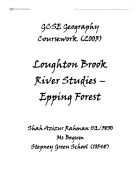Geography Coursework
The Changes in Loughton Brook as it Moves Downstream
My general aim for this enquiry is to investigate the processes and changes of Loughton Brook as it moves downstream. In order to do this I have chosen three theories to investigate.
To conduct my research I visited Loughton Brook in Epping Forest. Epping Forest lies to the north-east of London. It forms a large crescent of land stretching from Wanstead in the south to Epping in the north. The main part of the 19km forest lies on a high ridge of land (a watershed) between the valleys of the River Lea to the west and the River Roding to the east. On top of the ridge are patches of pebble gravel overlying bagshot beds which consist mainly of sand and clay, and at the bottom of the ridge is London clay. The top two layers are essentially free draining while the lower layers are relatively impermeable. This gives rise to a series of springs which emerge at the junctions between different layers. These springs are the source of a number of streams which drain the edges of the Epping Forest ridge. One of the largest is Loughton Brook which rises near High Beach and flows through the urban area of Loughton in to the River Roding.
The Changes in Loughton Brook as it Moves Downstream
My general aim for this enquiry is to investigate the processes and changes of Loughton Brook as it moves downstream. In order to do this I have chosen three theories to investigate.
To conduct my research I visited Loughton Brook in Epping Forest. Epping Forest lies to the north-east of London. It forms a large crescent of land stretching from Wanstead in the south to Epping in the north. The main part of the 19km forest lies on a high ridge of land (a watershed) between the valleys of the River Lea to the west and the River Roding to the east. On top of the ridge are patches of pebble gravel overlying bagshot beds which consist mainly of sand and clay, and at the bottom of the ridge is London clay. The top two layers are essentially free draining while the lower layers are relatively impermeable. This gives rise to a series of springs which emerge at the junctions between different layers. These springs are the source of a number of streams which drain the edges of the Epping Forest ridge. One of the largest is Loughton Brook which rises near High Beach and flows through the urban area of Loughton in to the River Roding.







